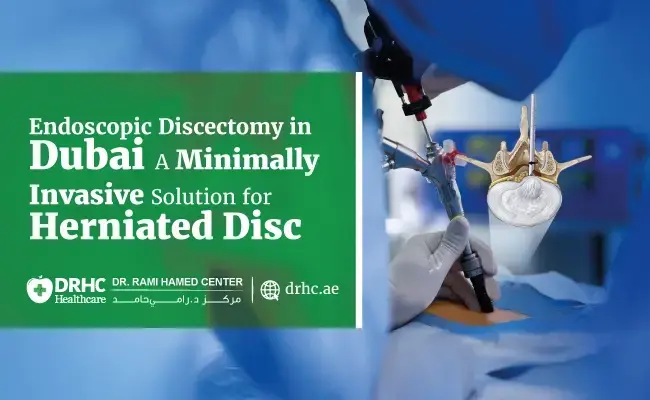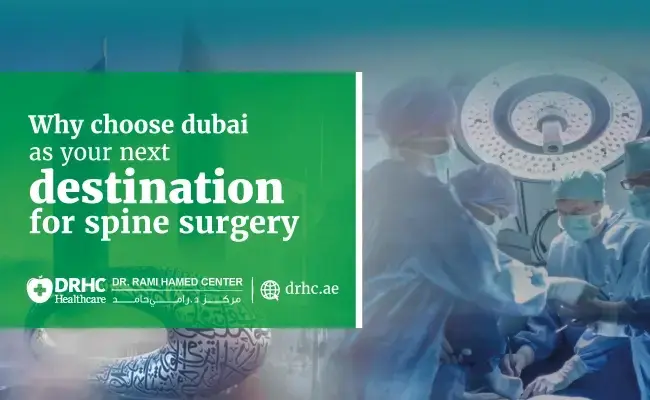
When it comes to advanced spinal care, Dr. Rami Hamed and the team at Dr. Rami Hamed Center (DRHC) Dubai is at the forefront of delivering minimally invasive solutions that prioritize patient safety, faster recovery, and lasting results. One of the most sought-after procedures offered at our center is Endoscopic Discectomy, a cutting-edge alternative to traditional open spine surgery for treating herniated discs and certain types of spinal stenosis.
In this blog post, we break down exactly how endoscopic discectomy is done, step-by-step, guided by the expertise of Dr. Rami Hamed, Consultant Orthopedic and Spine Surgeon.
What Is Endoscopic Discectomy?
Endoscopic Discectomy is a minimally invasive spine surgery used to remove herniated disc material that is pressing on a nerve root or the spinal cord. Unlike traditional surgery that requires large incisions and muscle dissection, this procedure uses a tiny camera (endoscope) and specialized instruments through a small skin incision—leading to less pain, minimal scarring, and quicker recovery.
Indications for Endoscopic Discectomy
Dr. Rami Hamed typically recommends endoscopic discectomy for patients experiencing:
- Herniated or bulging lumbar discs
- Sciatica or nerve compression symptoms
- Failed response to conservative treatments (physiotherapy, medication)
- Localized disc problems visible on MRI
Step-by-Step: How Endoscopic Discectomy Is Performed at DRHC Dubai
1. Preoperative Evaluation and Imaging
Every surgical journey begins with a thorough consultation, including a review of the patient's symptoms, neurological assessment, and detailed imaging (MRI or CT scans). Dr. Rami Hamed uses this data to precisely localize the disc herniation and plan the approach.
2. Anesthesia and Positioning
The procedure is performed under local anesthesia with sedation or sometimes general anesthesia, depending on the case. The patient is positioned prone (face down) on a radiolucent operating table to allow proper access to the affected spinal level.
3. Skin Marking and Fluoroscopic Guidance
Using a C-arm fluoroscopy machine, the surgical level is marked on the skin. A small incision (around 8 mm) is made on the side of the back near the affected disc.
4. Insertion of the Working Channel
Through the incision, a guide wire and a series of dilators are gently passed to separate the muscles rather than cutting them. A working cannula (tube) is inserted, and the endoscope is introduced through it, providing a high-definition view of the surgical site on a monitor.
5. Visualizing the Herniated Disc
Dr. Rami Hamed carefully identifies the herniated disc fragment compressing the nerve. With enhanced magnification and precision, the disc material is removed using micro-instruments under direct endoscopic vision.
6. Nerve Root Decompression
Once the disc fragment is removed, Dr. Rami ensures that the nerve root is completely free from compression. He checks for pulsation and mobility to confirm successful decompression.
7. Closure
After confirming proper decompression and minimal bleeding, the endoscope and cannula are withdrawn. The tiny incision is closed with a single stitch or surgical tape, often requiring no stitches at all.
Explore Our Related Blogs
- Tried Everything for Back Pain? You May Be a Candidate for Endoscopic Surgery
- Is Back Pain Keeping You Up at Night? Here’s What You Can Do
- Why Some People Wait Too Long to Fix Their Back Pain
- MRI Done — What’s Next for Your Herniated Disc or Sciatica?
- Endoscopic Discectomy Explained: A Modern Solution for Herniated Discs
- What Makes Minimally Invasive Spine Surgery So Effective?
- Benefits of Endoscopic Spine Surgery vs Traditional Surgery
- Why Endoscopic Spine Surgery Is a Game Changer
Recovery After Endoscopic Discectomy
One of the major advantages of this technique is the quick recovery:
- Same-day discharge in many cases
- Minimal post-op pain and reduced need for medications
- Return to light activities within a few days
- Resume work or normal life in 2–4 weeks (case-dependent)
- Physiotherapy support may be advised for optimal spine health
Dr. Rami Hamed's Insight
“Endoscopic discectomy represents a shift towards precision-based, patient-friendly spine surgery. My goal is to relieve nerve pressure with minimal trauma, so patients can heal faster and get back to living fully.”
— Dr. Rami Hamed, Consultant Spine Surgeon
Why Choose DRHC Dubai for Endoscopic Discectomy?
- Advanced minimally invasive techniques
- State-of-the-art surgical suites
- Personalized care by Dr. Rami Hamed, a leader in orthopedic and spine surgery
- Short hospital stays and rapid return to normal life
Book a Consultation with Dr. Rami Hamed
If you’re suffering from back pain, sciatica, or disc-related issues and are considering surgery, contact DRHC Dubai today for a second opinion or a detailed evaluation. To book your appointment please call +97142798200 today!
Topic: orthopedic Back Pain Spine Surgery




.jpg)




Leave a comment